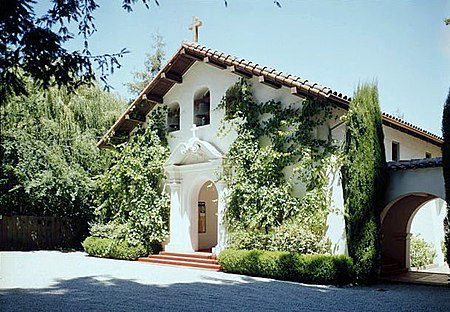Our Lady of the Wayside Church

Our Lady of the Wayside Church is a modest church built in 1912 for the then-growing Catholic parish of Portola Valley by a combined effort of Jewish, Protestant and Catholic members of The Family, a San Francisco men's club that owns a nearby rural retreat. The building itself was constructed of steel-reinforced concrete with stucco finish in the Mission Revival style, with the added Georgian element of the main doorway with its scrolled pediment. Mission Revival features include the tiled gable roof with exposed rafter ends, round-arched windows and buttressed side walls.James Rupert Miller, an architect and a member of The Family, gave the assignment of designing the church to a rising young draftsman at his firm: Timothy L. Pflueger. The building was 19-year-old Pflueger's first commission. Pflueger drew on his familiarity with Mission San Francisco de Asís in his native San Francisco for inspiration.In 1977, a plaque was placed proclaiming the building as California Registered Historical Landmark number 909. The church was also added to the National Register of Historic Places in 1977.The historic church suffered extensive damage in the 1989 Loma Prieta earthquake, and was recommended for demolition by structural experts. Instead, it was repaired by its congregation at a cost of US$600,000.
Excerpt from the Wikipedia article Our Lady of the Wayside Church (License: CC BY-SA 3.0, Authors, Images).Our Lady of the Wayside Church
Portola Road,
Geographical coordinates (GPS) Address External links Nearby Places Show on map
Geographical coordinates (GPS)
| Latitude | Longitude |
|---|---|
| N 37.3839 ° | E -122.2338 ° |
Address
Our Lady of the Wayside Roman Catholic Church
Portola Road
94028
California, United States
Open on Google Maps







